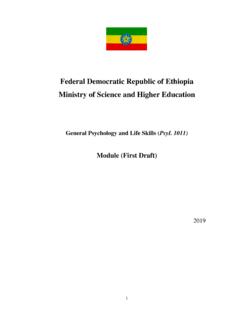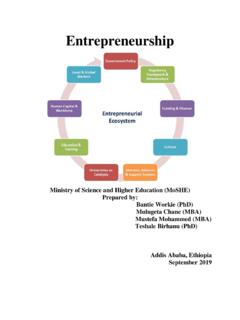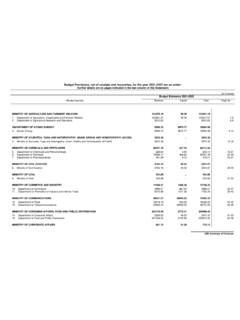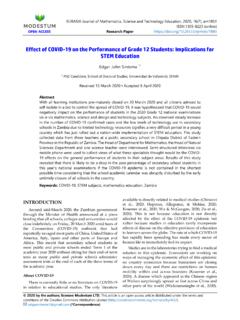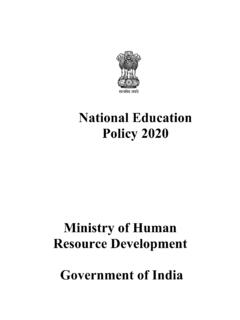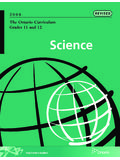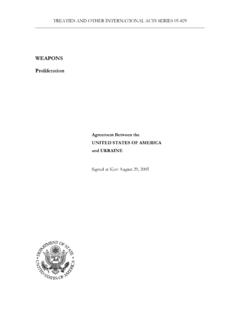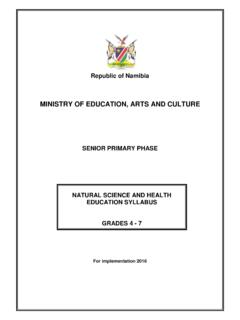Transcription of This module was prepared by the Ministry of Science and ...
1 This module was prepared by the Ministry of Science and Higher Education (MOSHE) in collaboration with these three Universities Bahir Dar University (Since, 1963), Adama Science & technology University (Since, 1993), Addis Ababa Science & technology University (Since, 2011) Introduction to Emerging Technologies Course module (EMTE1011/1012) Developed By: Tesfahunegn Minwuyelet (MSC) & Makonnen Wagaw ( ) CH-1, 4 & 5 from BDU Girma Debela (MSc) CH-2 from ASTU Yonnasa Tesfaye (MSc) CH-3, 6 & 7 from AASTU Compiled & Edited By: Tesfahunegn Minwuyelet (MSc) November 2019 1 module Preface This resource module is designed and developed in support of the Introduction to Emerging technology Curriculum.
2 It provides learning resources and teaching ideas. Dear students, in chapter one you have been studied about the evolution of technologies, the role of data for emerging technologies, programmable devices, human to machine interaction and future trends in emerging technologies within week 1-2. In chapter two, data Science and Big data have been studied, how we collect, analyzed, stored and used. The advantages and disadvantages of big data analysis are also studied within weeks 3-4. In chapter three, you have been studied about introduction to Artificial Intelligence; its history; different types of AI; its application in health, education, agriculture, and business.
3 Finally, different tools and platforms used for AI and sample AI examples were studied within week 5-7. In chapter four, the overview of the Internet of Things; its history; its pros and cons, its architecture, its application in the smart home, smart city, smart grid and smart farming. In the end, all IoT tools and platforms, as well as the sample applications, are well studied within weeks 8-10. Chapter five is about augmented reality (AR), its difference and similarity from virtual reality and mixed reality, how it works, its architecture, and applications were studied within weeks 11-12. Chapter six is all about the connection of emerging technologies with professional ethics, privacy, accountability, trust.
4 Finally, the threats and challenges of the technologies have been discussed within week 13. In chapter seven, other emerging technologies that are not covered in detail are discussed. Nanotechnology, Biotechnology, Blockchain technology , Cloud and quantum computing, Autonomic computing, Computer vision, Embedded systems, Cybersecurity, and Additive Manufacturing (3D Printing) were studied within week 14-15. 2 Table of Contents Chapter 1: Introduction to Emerging Technologies .. 8 Evolution of Technologies .. 8 Introduction to the Industrial Revolution (IR) .. 10 The Most Important Inventions of the Industrial Revolution.
5 11 Historical Background (IR , IR , IR ) .. 11 Role of Data for Emerging Technologies .. 14 Enabling devices and network (Programmable devices) .. 15 List of some Programmable devices .. 16 Human to Machine Interaction .. 17 Disciplines Contributing to Human-Computer Interaction (HCI) .. 17 Future Trends in Emerging Technologies .. 18 Emerging technology trends in 2019 .. 18 Some emerging technologies that will shape the future of you and your business .. 18 Chapter One Review Questions .. 20 Chapter 2: Data Science .. 21 An Overview of Data Science .. 21 What are data and information? .. 23 Data Processing Cycle .. 23 Data types and their representation.
6 24 Data types from Computer programming perspective .. 24 Data types from Data Analytics perspective .. 25 Data value Chain .. 26 Data Acquisition .. 27 Data Analysis .. 27 Data Curation .. 27 Data Storage .. 27 Data Usage .. 28 Basic concepts of big data .. 28 What Is Big Data? .. 28 Clustered Computing and Hadoop Ecosystem .. 29 Clustered Computing .. 29 Hadoop and its Ecosystem .. 30 3 Big Data Life Cycle with Hadoop .. 32 Chapter Two Review Questions .. 34 Chapter 3: Artificial Intelligence (AI) .. 35 What is Artificial Intelligence (AI) .. 35 Need for Artificial Intelligence .. 38 Goals of Artificial 38 What Comprises to Artificial Intelligence?
7 38 Advantages of Artificial Intelligence .. 39 Disadvantages of Artificial 40 History of AI .. 41 Levels of AI .. 44 Types of AI .. 47 How humans think .. 49 Mapping human thinking to artificial intelligence components .. 50 Influencers of artificial intelligence .. 51 Big Data .. 51 Cloud computing and application programming interfaces .. 54 The emergence of data Science .. 55 Applications of AI .. 55 AI tools and 57 Semple AI application .. 59 Chapter Three Review Questions .. 62 Chapter 4: Internet of Things (IoT) .. 63 Overview of IoT .. 63 What is IoT? .. 64 History of IoT .. 66 IoT Advantages .. 67 IoT 68 Challenges of IoT.
8 69 How does it work? .. 69 Architecture of 70 Devices and Networks .. 72 IoT Tools and Platforms .. 74 4 IoT Based Smart Home .. 78 IoT Based Smart City .. 79 IoT Based Smart Farming .. 80 Chapter Four Review Questions .. 81 Chapter 5: Augmented Reality (AR) .. 82 Overview of augmented reality .. 82 Virtual reality (VR), Augmented Reality (AR) vs Mixed reality (MR).. 83 Virtual Reality (VR).. 83 Augmented Reality (AR) .. 84 Mixed Reality (MR) .. 85 The architecture of AR Systems .. 87 Applications of AR Systems .. 89 AR In education .. 89 AR In Medicine .. 90 AR In Entertainment .. 92 Chapter Five Review Questions.
9 94 Chapter 6: ETHICS AND PROFESSIONALISM OF EMERGING TECHNOLOGIES .. 95 technology and ethics .. 95 New ethical questions .. 96 General ethical principles .. 97 Professional responsibilities.. 98 Professional leadership principles.. 98 Digital privacy .. 99 Information Privacy .. 99 Communication Privacy .. 100 Individual Privacy .. 100 Some digital privacy principles .. 101 Accountability and trust .. 101 Treats and challenges .. 102 Ethical and regulatory challenges .. 102 Treats .. 105 Chapter Six Review Questions .. 107 Chapter 7: Other emerging technologies .. 108 5 Nanotechnology .. 108 How it started .. 108 Fundamental concepts in nanoscience and nanotechnology.
10 109 Applications of nanotechnology: .. 111 Biotechnology .. 111 History .. 112 Application of biotechnology .. 113 Blockchain technology .. 113 History .. 116 Blockchain Explained .. 116 The Three Pillars of Blockchain technology .. 117 How Blockchain Works .. 119 Why do people use the peer-to-peer network? .. 121 Application of blockchain .. 121 Cloud and quantum computing .. 123 Cloud computing .. 123 Advantages of cloud 124 Quantum computing .. 124 Advantages of quantum computing .. 125 Autonomic computing (AC) .. 126 Characteristics of Autonomic Systems .. 126 Computer vision .. 128 History .. 128 Definition.
